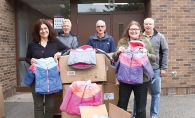ONLINE HED: Cherise Vincent, one of the first bone marrow transplant recipients with SCIDS, is now spreading the word at Be The Match.
Being The Match
One of the first SCIDS bone marrow transplant recipients is spreading the word.
by
Maggie
Kelly
Photo courtesy of cherise vincent
Cherise Vincent works in human resources at
Be The Match (bethematch.org), the national bone marrow transplant registry.
In 1977, 9-month-old infant Cherise Vincent was dying. Born without an immune system, she was diagnosed with severe combined immune deficiency syndrome (SCIDS). With no solution in sight, doctors suggested a bone marrow transplant to Vincent’s parents.
“It was the first bone marrow transplant for my condition,” says Vincent, who lives in Maple Grove. Success had been found in the case of blood cancers, but for SCIDS, “They didn’t know if it would work.”
Her brothers, ages 4 and 8, and sister, age 2, were all tested for compatibility, and her brother, Richmond Jr., was a match. This was extremely lucky, considering that only 30 percent of people have a match within their family, and at that time, there was no broader program that allowed doctors to find a match.
The transplant didn’t take immediately. The doctors said that hope was gone and her family planned a funeral. But baby Cherise pulled through. She stayed in the hospital for months, learned to walk and was potty trained there.
She had frequent check-ins and nervous parents, but after the age of 5, Vincent had a normal childhood, except for the teasing. She would tell kids at school what had happened. They thought it was strange and left her out of games. She soon stopped talking about it altogether.
Vincent dismissed it until her junior year at the U of M. She got a call, and when she answered with “Cherise Vincent,” the voice on the other end of the line replied in disbelief. “I was your nurse,” the voice said, and explained she had seen Vincent’s name and had to find out if it was the same girl. Vincent was confused about why this was so important. The nurse continued, “You don’t understand, there were eight of you —no one else made it past [age] 16.” It was then that Vincent realized how special she was. “I became comfortable with it again,” she says. This was good, because the syndrome wasn’t done with her.
In her early 20s, she became sick with graph-versus-host disease, a complication of the transplant. Today, she says, “I’m 37 years old, in remission, and my immune system is great.”
Through a series of serendipitous events, Vincent received a position in the human resources department at Be The Match, the national bone marrow transplant registry, spreading the word on the need for donors and debunking myths surrounding the donation process.
Betsy Ward, a Be The Match regional manager for community engagement, explains there are two ways to donate: Peripheral blood stem cell donation, which is a process similar to donating platelets and is non-surgical, and traditional bone marrow donation, which is surgical and involves sedation, but is not painful. When Vincent needed the transplant, the procedure was still new, and extremely painful for her brother. But time and technology have changed, and donors need not be discouraged by the pain myth.
What is not a myth is that a wide variety of donors is needed. But donating isn’t the only way to help. “We love people to give, and we love people to volunteer,” Ward says.
With her position at Be The Match, Vincent is more aware than ever of what she and her family went through. “I know that I’m still special. I have to work out. I have to eat well. I’m the oldest survivor and I’d like to stay that.” //
Cherise Vincent works in human resources at Be The Match, the national bone marrow transplant registry.
In 1977, 9-month-old infant Cherise Vincent was dying. Born without an immune system, she was diagnosed with severe combined immune deficiency syndrome (SCIDS). With no solution in sight, doctors suggested a bone marrow transplant to Vincent’s parents.
“It was the first bone marrow transplant for my condition,” says Vincent, who lives in Maple Grove. Success had been found in the case of blood cancers, but for SCIDS, “They didn’t know if it would work.”
Her brothers, ages 4 and 8, and sister, age 2, were all tested for compatibility, and her brother, Richmond Jr., was a match. This was extremely lucky, considering that only 30 percent of people have a match within their family, and at that time, there was no broader program that allowed doctors to find a match.
The transplant didn’t take immediately. The doctors said that hope was gone and her family planned a funeral. But baby Cherise pulled through. She stayed in the hospital for months, learned to walk and was potty trained there.
She had frequent check-ins and nervous parents, but after the age of 5, Vincent had a normal childhood, except for the teasing. She would tell kids at school what had happened. They thought it was strange and left her out of games. She soon stopped talking about it altogether.
Vincent dismissed it until her junior year at the U of M. She got a call, and when she answered with “Cherise Vincent,” the voice on the other end of the line replied in disbelief. “I was your nurse,” the voice said, and explained she had seen Vincent’s name and had to find out if it was the same girl. Vincent was confused about why this was so important. The nurse continued, “You don’t understand, there were eight of you —no one else made it past [age] 16.” It was then that Vincent realized how special she was. “I became comfortable with it again,” she says. This was good, because the syndrome wasn’t done with her.
In her early 20s, she became sick with graph-versus-host disease, a complication of the transplant. Today, she says, “I’m 37 years old, in remission, and my immune system is great.”
Through a series of serendipitous events, Vincent received a position in the human resources department at Be The Match, the national bone marrow transplant registry, spreading the word on the need for donors and debunking myths surrounding the donation process.
Betsy Ward, a Be The Match regional manager for community engagement, explains there are two ways to donate: Peripheral blood stem cell donation, which is a process similar to donating platelets and is non-surgical, and traditional bone marrow donation, which is surgical and involves sedation, but is not painful. When Vincent needed the transplant, the procedure was still new, and extremely painful for her brother. But time and technology have changed, and donors need not be discouraged by the pain myth.
What is not a myth is that a wide variety of donors is needed. But donating isn’t the only way to help.
“We love people to give, and we love people to volunteer,” Ward says.
With her position at Be The Match, Vincent is more aware than ever of what she and her family went through.
“I know that I’m still special. I have to work out. I have to eat well. I’m the oldest survivor and I’d like to stay that.”









